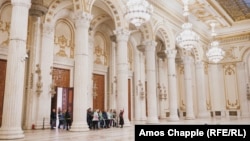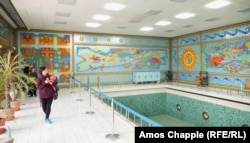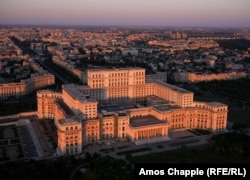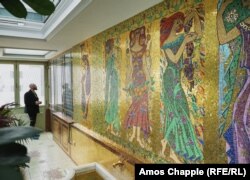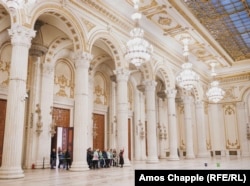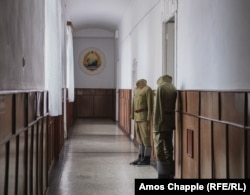Decades after the bloody overthrow of Nicolae Ceausescu, tourism based on landmarks from Romania's communist era has become a thriving industry.
BUCHAREST -- Christian Scutariu laughs when asked why 400 tourists line up daily to visit the "Ceausescu Mansion" where he works as a guide.
"Because most of the foreigners didn't have a chance to experience communism," he said. "They didn't live through such things, so it's hard for them to understand, but they are very curious about it."
The Bucharest mansion is where Nicolae Ceausescu and his family bathed under golden faucets and strolled through gardens populated by peacocks and secret police as the Romanian people outside were forced into a dark age of shortages, restrictions and repression. The residence opened to the public as a museum in 2016 but has already climbed into the top-10-ranked tourism sites in Romania.
Scutariu told RFE/RL around two-thirds of the visitors to the site are foreigners and, until the pandemic upended tourism statistics, the museum was seeing numbers increase by around 25 percent each year.
At Bucharest's hulking Palace of the Parliament -- Ceausescu's most infamous megaproject -- a similar story has unfolded over the past decade.
In 2013, slightly less than 150,000 tourists -- more than 80 percent of them foreigners -- walked the building's imposing corridors. By 2018, that number had shot up to more than 260,000, a nearly 80 percent increase. That growth significantly outpaced Romania's total incoming foreign tourist numbers, which grew by around 65 percent in the same period.
Vlad Chiciudean, who runs communist-themed tours in Bucharest, told RFE/RL: "After the [1989 Romanian Revolution], we didn't want anything to do with these memories of communism. We wanted to expel it from our lives."
Over time, however, especially after Romania's accession to the European Union in 2007 streamlined entry into the country, many spotted an opportunity.
"We saw, 'Hmm, OK, this stuff sells,'" the tour guide said.
Chiciudean says that in the past five years, several museums and other attractions with a communist theme have opened throughout the country.
"Most Romanians don't understand why foreigners want, as much as they do, to know things about communism. But if there is an interest there, then we can take advantage of it," he says.
Capitalizing on foreign fascination with communist relics has been embraced in Romania in a way not all of Europe's formerly socialist republics have managed. In Albania, the residence of notorious Stalinist dictator Enver Hoxha remains closed to the public.
While the cavernous halls of the Bucharest parliament and gaudy luxury of the Ceausescu residence hold an obvious aesthetic draw, even some dreary and out-of-the-way places see thousands of visits from tourists interested in the landmarks of Romania's communist past.
In Targoviste, a small town 70 kilometers northwest of Bucharest, around 4,500 mostly foreign tourists in 2022 paid to enter the courtyard where Ceausescu and his wife, Elena, were shot dead by a firing squad on December 25, 1989.
In a surprisingly frank media interview in 2013 when the Targoviste barracks was opened to the public, Adrian Tutuianu, head of the local council, told AFP that the execution site was "another asset to attract more tourists," which he anticipated would "have a very good effect on the economic activity of the region."
A tourist who visited the Targoviste site in 2018 indicated the atmosphere in which much of the "dark tourism" of Romania's communist-era sites is made:
"I had a lump in my throat seeing those simple, smelly rooms, the red phone, and the wall where they were shot," the tourist wrote in her online review. "Seeing it, I felt like [the executions that ended communist rule in Romania] happened a couple years ago, not 29."




